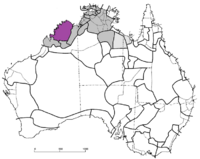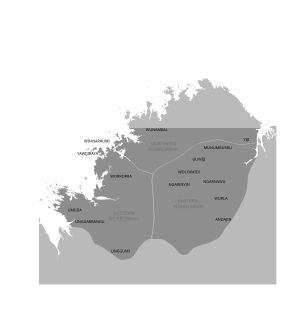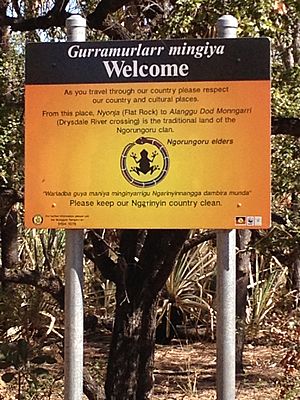Ngarinyin language facts for kids
Quick facts for kids Ngarinyin |
|
|---|---|
| Eastern Worrorran Ungarinjin |
|

Worrorran languages (purple), among other non-Pama-Nyungan languages (grey)
|
|
| Region | Western Australia |
| Ethnicity | Ngarinjin, Wurla (Waladjangarri) |
| Native speakers | 59 (2021 census) |
| Language family |
Worrorran
|
| Dialects |
Ngarinyin
Guwidj (Orla)
Munumburru
Wolyamidi
Andadjin
Worla (Waladja)
Ngarnawu
Waladjangari
|
| Writing system | Latin |
| AIATSIS | K18 Ngarinyin, K19, K25 |

Map showing Worrorran languages
|
|
The Ngarinyin language, also called Ungarinjin, is an Aboriginal language from the Kimberley area in Western Australia. It's spoken by the Ngarinyin people. Sadly, it's an endangered language, meaning very few people still speak it today.
Contents
What is Ngarinyin?
Ngarinyin belongs to a group of languages called Worrorran languages. Other languages in this group are Wunambal and Worrorra.
Ngarinyin itself is like a group of closely related ways of speaking, called dialects. Some people even think these dialects are separate languages. Famous language experts like Robert M. W. Dixon and Claire Bowern have listed several dialects. These include Guwidj, Waladja, Ngarnawu, Andadjin, Munumburru, Wolyamidi, and Waladjangarri.
The name "Ngarinyin" can refer to both the language and the people who speak it. However, "Ungarinjin" usually only refers to the language. The community has chosen "Ngarinyin" as the main name for their language.
How many people speak Ngarinyin?
In 2016, only 38 people said they spoke Ngarinyin at home. This makes it a critically endangered language. It is also considered "moribund," which means it's very close to disappearing.
People are working hard to record the language. They want to write down its words and grammar rules before it's too late. This includes understanding special parts of the language, like how family members are named.
Ngarinyin is mostly spoken in the Northern Kimberley area of Australia. Because there are so few Ngarinyin speakers, other local languages are more common nearby. These include other Worrorran languages like Wunambal and Worrorra.
Ngarinyin used to be one of the most common Aboriginal languages in Northern Kimberley. Now, only a small number of older people still know it. Younger generations often use Kriol instead. However, some young people still know a little bit of Ngarinyin.
Family words in Ngarinyin
Ngarinyin has a very detailed way of classifying family members. This system is very similar to the Worrorra and Wunambal languages. It's quite unique compared to other Aboriginal kinship systems.
One interesting thing is that the same word can be used for family members from different generations. For example, the English words "wife's brother," "wife's father," and "wife's father's father" all use the same Ngarinyin word: waiingi.
Sounds of Ngarinyin
Like all languages, Ngarinyin has its own set of sounds. These sounds are made using different parts of your mouth.
Vowel sounds
Ngarinyin has five main vowel sounds. Some of these can be short or long.
| Front | Back | |
|---|---|---|
| High | i iː | u uː |
| Mid | e | o |
| Low | a aː | |
Consonant sounds
Ngarinyin also has many consonant sounds. These are made by blocking air in different ways with your lips, tongue, and throat.
| Lips | Tongue Tip | Curled Tongue | Middle Tongue | Back Tongue | |
|---|---|---|---|---|---|
| Stop | p | t | ʈ | c | k |
| Nasal | m | n | ɳ | ɲ | ŋ |
| Side | l | ɭ | ʎ | ||
| R-like | r | ɻ | |||
| Glide | w | j |


